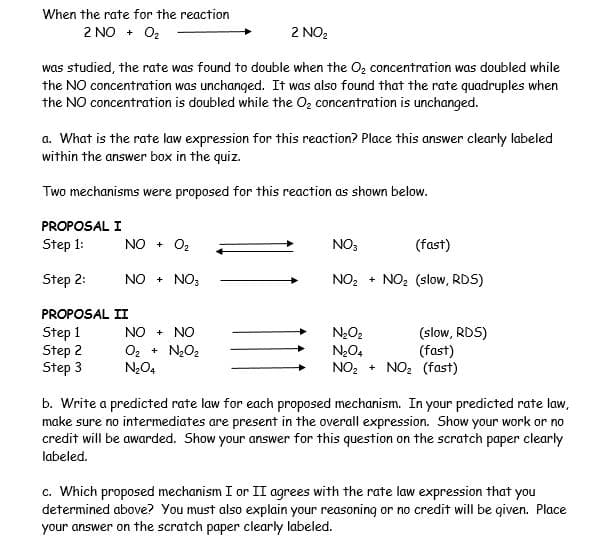When the rate for the reaction 2 NO + 02 2 NO2 was studied, the rate was found to double when the O, concentration was doubled while the NO concentration was unchanged. It was also found that the rate quadruples when the NO concentration is doubled while the Oz concentration is unchanged. a. What is the rate law expression for this reaction? Place this answer clearly labeled within the answer box in the quiz. Two mechanisms were proposed for this reaction as shown below. PROPOSAL I Step 1: NO + O2 NO, (fast) Step 2: NO + NO: NO2 + NO, (slow, RDS) PROPOSAL II Step 1 Step 2 Step 3 NO + NO Oz + NO2 NO, NO2 N0. NO2 + NO2 (fast) (slow, RDS) (fast) b. Write a predicted rate law for each proposed mechanism. In your predicted rate law, make sure no intermediates are present in the overall expression. Show your work or no credit will be awarded. Show your answer for this question on the scratch paper clearly labeled. c. Which proposed mechanism I or II agrees with the rate law expression that you determined above? You must also explain your reasoning or no credit will be given. Place your answer on the scratch paper clearly labeled.
When the rate for the reaction 2 NO + 02 2 NO2 was studied, the rate was found to double when the O, concentration was doubled while the NO concentration was unchanged. It was also found that the rate quadruples when the NO concentration is doubled while the Oz concentration is unchanged. a. What is the rate law expression for this reaction? Place this answer clearly labeled within the answer box in the quiz. Two mechanisms were proposed for this reaction as shown below. PROPOSAL I Step 1: NO + O2 NO, (fast) Step 2: NO + NO: NO2 + NO, (slow, RDS) PROPOSAL II Step 1 Step 2 Step 3 NO + NO Oz + NO2 NO, NO2 N0. NO2 + NO2 (fast) (slow, RDS) (fast) b. Write a predicted rate law for each proposed mechanism. In your predicted rate law, make sure no intermediates are present in the overall expression. Show your work or no credit will be awarded. Show your answer for this question on the scratch paper clearly labeled. c. Which proposed mechanism I or II agrees with the rate law expression that you determined above? You must also explain your reasoning or no credit will be given. Place your answer on the scratch paper clearly labeled.
Chemistry: The Molecular Science
5th Edition
ISBN:9781285199047
Author:John W. Moore, Conrad L. Stanitski
Publisher:John W. Moore, Conrad L. Stanitski
Chapter11: Chemical Kinetics: Rates Of Reactions
Section11.2: Effect Of Concentration On Reaction Rate
Problem 11.3PSP
Related questions
Question

Transcribed Image Text:When the rate for the reaction
2 NO + O2
2 NO2
was studied, the rate was found to double when the O, concentration was doubled while
the NO concentration was unchanged. It was also found that the rate quadruples when
the NO concentration is doubled while the Oz concentration is unchanged.
a. What is the rate law expression for this reaction? Place this answer clearly labeled
within the answer box in the quiz.
Two mechanisms were proposed for this reaction as shown below.
PROPOSAL I
Step 1:
NO + O2
NO3
(fast)
Step 2:
NO + NO:
NO, + NO: (slow, RDS)
PROPOSAL II
Step 1
Step 2
Step 3
NO + NO
NO2
O2 +
N204
NO2
(slow, RDS)
(fast)
NO2 (fast)
N20,
NO2 +
b. Write a predicted rate law for each proposed mechanism. In your predicted rate law,
make sure no intermediates are present in the overall expression. Show your work or no
credit will be awarded. Show your answer for this question on the scratch paper clearly
labeled.
c. Which proposed mechanism I or II agrees with the rate law expression that you
determined above? You must also explain your reasoning or no credit will be qiven. Place
your answer on the scratch paper clearly labeled.
Expert Solution
This question has been solved!
Explore an expertly crafted, step-by-step solution for a thorough understanding of key concepts.
This is a popular solution!
Trending now
This is a popular solution!
Step by step
Solved in 4 steps

Recommended textbooks for you

Chemistry: The Molecular Science
Chemistry
ISBN:
9781285199047
Author:
John W. Moore, Conrad L. Stanitski
Publisher:
Cengage Learning

Chemistry by OpenStax (2015-05-04)
Chemistry
ISBN:
9781938168390
Author:
Klaus Theopold, Richard H Langley, Paul Flowers, William R. Robinson, Mark Blaser
Publisher:
OpenStax

Chemistry: An Atoms First Approach
Chemistry
ISBN:
9781305079243
Author:
Steven S. Zumdahl, Susan A. Zumdahl
Publisher:
Cengage Learning

Chemistry: The Molecular Science
Chemistry
ISBN:
9781285199047
Author:
John W. Moore, Conrad L. Stanitski
Publisher:
Cengage Learning

Chemistry by OpenStax (2015-05-04)
Chemistry
ISBN:
9781938168390
Author:
Klaus Theopold, Richard H Langley, Paul Flowers, William R. Robinson, Mark Blaser
Publisher:
OpenStax

Chemistry: An Atoms First Approach
Chemistry
ISBN:
9781305079243
Author:
Steven S. Zumdahl, Susan A. Zumdahl
Publisher:
Cengage Learning

Chemistry
Chemistry
ISBN:
9781305957404
Author:
Steven S. Zumdahl, Susan A. Zumdahl, Donald J. DeCoste
Publisher:
Cengage Learning


Chemistry & Chemical Reactivity
Chemistry
ISBN:
9781133949640
Author:
John C. Kotz, Paul M. Treichel, John Townsend, David Treichel
Publisher:
Cengage Learning